 Petzlover
PetzloverAsian is originated from United Kingdom but Bombay is originated from United States. Both Asian and Bombay are of same weight. Both Asian and Bombay has almost same life span. Both Asian and Bombay has same litter size. Both Asian and Bombay requires Low Maintenance.
Known also as the Malayan, the Asian cat is likened to the Burmese but just with different coat patterns and colors.
This particular cat breed was developed in 1981 in the UK. Apparently there was a mistake mating between a Lilac Burmese and a Chinchilla Persian and kittens from these were born in 1981.
So beautiful were they that a breeding program started with new coat colors and patterns. The breed got the name ‘Asian’ with all the varieties reaching GCCF Championship status.
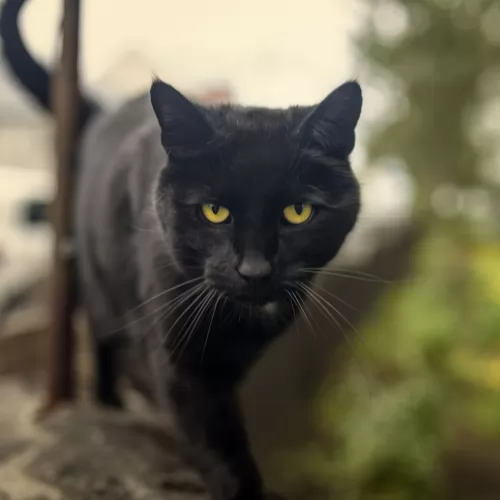 The Bombay cat was developed by breeding black American Shorthair cats and sable Burmese cats to bring about a sleek panther-like cat.
The Bombay cat was developed by breeding black American Shorthair cats and sable Burmese cats to bring about a sleek panther-like cat.
Cats of the Asian group are given the name Bombay cats. It is also known as the Black Mamba or mini-panther. In fact the Bombay cat was developed by Nikki Horner, a breeder from Kentucky, USA.
In 1976 the Bombay cat was successfully bred and was recognized and registered by the Cat Fanciers' Association in 1970 and also the International Cat Association.
The Asian cat is medium-sized and muscular. The male cat is somewhat bigger than the female and weighs roughly 5 – 7kg while the female will weigh roughly 3 – 5kg although most times, there is not much difference in size between the males and females.
The attractive cat has a round head and wide-spaced ears with large green eyes. It’s a slender cat, but athletic with slender legs and medium thickness tail. Asian cats come in a wide range of colors such as fawn, chocolate, black, blue, cinnamon. The coat is short, fine, and silky and the Asian doesn’t require too much grooming.
These are friendly, playful cats and they get on well with children if the children are kind, gentle and respectful with him. This is a fairly dependant cat and he will actually follow his favorite human being, crying out for attention.
The Asian is a social cat and can fit well into different homes. However, because it is a social cat, they require an owner that is willing to spend time with them. They’re cats that are sensitive to the moods of their owners and make excellent companions.
They’re adventurous cats and enjoy exploring and traveling, voicing their opinion on different things as well. The Asian thrives on the attention it gets from their human owners. It’s a sociable cat and is quite talkative too.
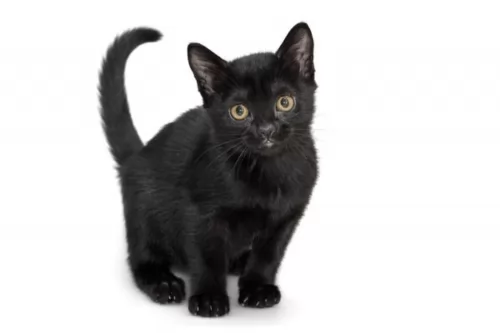 As a short-haired cat, the Bombay is related to the Burmese cat. It’s a medium-sized cat, muscular, lithe, and agile – like a black panther.
As a short-haired cat, the Bombay is related to the Burmese cat. It’s a medium-sized cat, muscular, lithe, and agile – like a black panther.
The cat weighs anything between 3 to 7kg. It is a stocky, compact cat with a round head and ears that are fairly rounded at the tips. The coat of the Bombay is short and glossy. In fact, it is the pitch-black short, close-lying shiny coat of the Bombay cat that makes it so distinctive and that with its green or copper-colored eyes. The cat’s nose as well as the pads of their paws, are also black
Bombay cats are very social, getting on well with all their human family members. They’re affectionate and like to demand attention from their humans.
They’re typical cats in many ways and are curious and alert. You wouldn’t describe the Bombay as an independent cat breed, although the older ones do become more independent as they mature but they are cats that dislike being left alone for long periods of time.
They are however adaptable to different lifestyles and can easily learn new tricks. They’re intelligent cats and will need toys that make him think. He always loves to play with the toys close to his human owner and has quite a loud meow and purr to voice his feelings
The Asian cat is such a sweet animal – gentle and affectionate and also very sociable. They are also curious and intelligent and vocal enough to let you know their needs. They're strong-willed if they want something.
The Asian makes an excellent companion for singles, couples, families or the elderly. They also get on well with children and with other pets in the home.
There are quite a few Asian cat varieties and each one promises to make you an excellent companion.
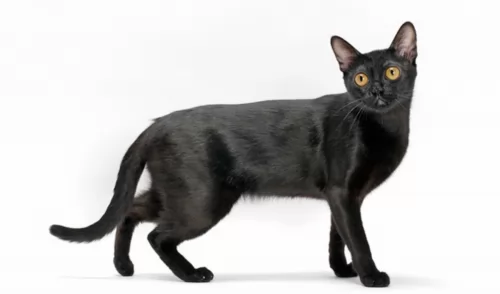 These sleek panther-like cats are a perfect choice if you want a cat that loves its human family.
These sleek panther-like cats are a perfect choice if you want a cat that loves its human family.
Every cat has got their peculiarities and these Bombay cats like heat – you’ll always find them curled up close to the fire or heaters. On a sunny day they’ll want to be outside soaking up the warmth.
Provide your Bombay with all the things he loves and he is guaranteed to make you the most awesome feline companion.
Although there are no specific health issues with this cat, because of it being associated with the Burmese, it may be more susceptible to diabetes mellitus than other breeds.
There are many cats in modern times developing diabetes mellitus – where they are unable to produce enough insulin to balance blood sugar. If the disease goes untreated it can lead to dehydration, vomiting, depression, weight loss, and even death. Your cat will be thirsty and urinating more frequently. There are various treatments and the diet for the cat will need to change too.
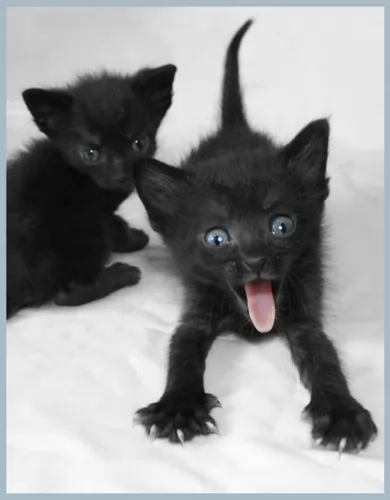 With good care these amazing cats can live to be between 15 and 20 years of age. Your Bombay, just like with other pets, can have any one of the health problems that cats are known for.
With good care these amazing cats can live to be between 15 and 20 years of age. Your Bombay, just like with other pets, can have any one of the health problems that cats are known for.
One of these diseases is craniofacial defect where there is a deformity of the head. Kittens with this deformity are always euthanized.
Vomiting is a sign that all is not well with your cat. Vomiting is actually a common problem with cats and is indicative of a number of causes. It could mean your cat has eaten something inedible, it could mean an infection or even a urinary tract problem.
Remember that ongoing vomiting can lead to dehydration so if your cat continues you must get him to the vet as soon as possible.
Feline Lower Urinary Tract Disease for instance can affect both your male or female cat. There are a number of causes of which stress and being overweight are just two.
You’ll notice your cat battling to urinate, blood in the urine, lack of appetite, restless and licking around the urinary area because of pain. Certainly, this is one reason you want to get your beloved cat to the vet.
To take care of the cat’s shiny coat, you can gently brush your Asian every week, not more, as they are short-haired cats, they’re not heavy shedders and they are low maintenance.
Age and general health will influence the way you feed your Asian cat. You’ll want to be feeding your feline friend the very best food there is as this will contribute towards his good health.
If you opt to feed your cat a commercially manufactured cat food, higher protein levels in wet foods might be better for your carnivorous pet. You don’t want to provide your cat with a high protein diet that is deficient in amino acids.
That is why it is important to research cat foods and their ingredients and get to know what are the most important ingredients for your cat to be getting. At all costs, avoid your cat becoming obese.
Make sure your cat has access to fresh cool water to maintain his body temperature.
Check your cat’s teeth, as he can’t convey to you that he is in pain – you need to check inside his mouth. Redness inside his ears might be indicative of an ear infection.
Whenever your cat seems to be ill, get him to the vet.
Provide your cat with a litter box that is kept hygienically clean.
Provide your cat with food- and water bowl, a brush for grooming and warm, dry sleeping basket.
Have your Asian neutered or spayed to prevent unwanted kittens.
Make sure your cat’s vaccines are up to date.
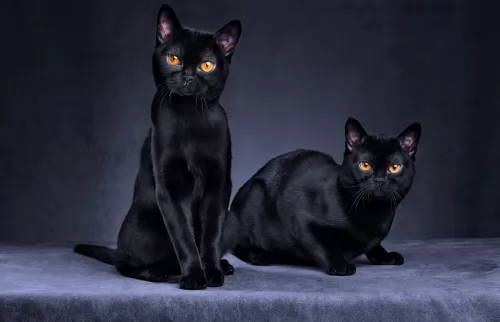 The Bombay isn’t a heavy shedder and requires very little grooming.
The Bombay isn’t a heavy shedder and requires very little grooming.
Provide your Bombay with the right kind of nutrition so that it has every chance to be strong and healthy. Cats are carnivores and you want to be sure that he gets the best food. Make sure that he gets home-made or commercially manufactured cat food that is high in meat protein. Do research or check with your vet to make sure he is being fed the best food there is for his age and activity levels.
Your Bombay requires a constant source of fresh, cool water night and day.
Check inside his mouth from time to time to ensure there are no rotting teeth causing him pain and discomfort. Also, check inside the ears ad make sure they aren’t red which could indicate an infection.
Always get your pet to the vet immediately you suspect that something is wrong.
Keep your cat’s litter box spotlessly clean.
Neuter or spay your Bombay cat to prevent unwanted kittens.Spaying and neuterings as some very beneficial health advantages for your furry friend as well.